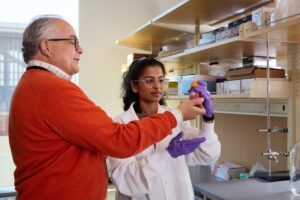The Next Generation Health Care Model

Published in UMB News | January 29, 2024
“We have a major opportunity to leverage new technologies to bring lifesaving therapies and new drugs and clinical trials to all the patients of Maryland, whether in West Baltimore or the Eastern Shore,” University of Maryland School of Medicine (UMSOM) Dean Mark T. Gladwin, MD, told members of the Maryland Senate’s Budget and Taxation Committee on Jan. 24 in Annapolis.
Gladwin, who is also the vice president for medical affairs at the University of Maryland, Baltimore (UMB) and the John Z. and Akiko K. Bowers Distinguished Professor, joined other top officials from UMB, the University of Maryland, College Park (UMCP), and the University of Maryland Medical System (UMMS) to explain the promise of the newly launched University of Maryland Institute for Health Computing (UM-IHC).
“For example, we’re now launching programs that use data science to identify women who are newly pregnant and have hypertension that are of high risk for preeclampsia and high mother-baby mortality,” Gladwin added. “We can identify patients across the state that are not being screened today for lung cancer and ensure that electronic consultation and patient navigation are provided for them as they are screening.”
Launched in November 2022, UM-IHC seeks to leverage recent advances in network medicine, artificial intelligence, and machine learning to create a premier learning health care system that evaluates both de-identified and secure digitized medical health data to improve outcomes for patients across the state of Maryland. UM-IHC is expected to energize research in the life sciences including applied artificial intelligence, bioinformatics, immersive visualization, real-world evidence and adaptive clinical trials, population health, and therapeutic drug discovery. While driving technological advancement, the goal is to also provide critical mass to Maryland’s technology economy.
Although UM-IHC’s physical offices are located in Montgomery County, home to a burgeoning cluster of more than 300 biotechnology companies, the institute is fueled by the partnership of UMB’s medical expertise, UMCP’s advanced computing prowess, and the vast medical records of UMMS, which provides more than 25 percent of all Maryland hospital-based care for more than 2 million patients.
“The University of Maryland Institute for Health Computing was envisioned to improve the health of the citizens of Maryland. And this is possible because of the deep expertise you will hear about in computing at College Park and health care at the University of Maryland, Baltimore, and electronic medical records at the University of Maryland Medical System and in collaboration with Montgomery County,” UMB President Bruce E. Jarrell, MD, FACS, said.
Jarrell’s counterpart, UMCP President Darryll Pines, PhD, MS, told the committee that the bill before them, Senate Bill 376, would provide crucial support for UM-IHC and help make Maryland a “national pioneering leader” helping to create the next generation health care model.
“Last summer, Gov. Wes Moore told the Maryland Association of Counties that the state needed to prioritize our spending in a way that strengthens our economic engine, not just for now, but for the future of all Marylanders, and leaves no Marylander behind,” he said. “So, with your support, this legislation and investment in the IHC will do just that by making Maryland not only a super cluster of high-tech innovation and economic impact, but also the foundation of a new and healthier future for every citizen of the state of Maryland, and potentially the nation.”
So far, Montgomery County has committed $40 million to the project over five years, matched by a $30 million commitment from UMB and UMCP via their 12-year collaboration, the University of Maryland Strategic Partnership: MPowering the State (MPower). Last year, the Maryland congressional delegation provided an initial $3 million for equipment. And UMMS has contributed a multimillion-dollar electronic health records database. The terms of the bill under consideration by the Maryland General Assembly would provide an additional $1.5 million through MPower in Fiscal Year 2025, increasing to $6 million each year, beginning in Fiscal Year 2029.
Beyond groundbreaking advances in health care, the UM-IHC is also expected to help address health inequities in Maryland, explained Gladwin.
“We’re facing a disruptive revolution in artificial intelligence that is now changing the practice of medicine overnight,” he said. “The major risk of this revolution is the use of data from a homogeneous patient population to create algorithms for all populations. These new programs are not necessarily representative of diverse populations and may introduce major bias and even fabrication in health care models. We have a major opportunity and responsibility in the state of Maryland to ensure that these new systems are free of bias, and serve all of our patients, regardless of color or socioeconomic status.”
UMMS President and CEO Mohan Suntha, MD, MBA, added, “When you think about who we are as a health system, we are everything from academic health care in urban-based environments like the city of Baltimore, we are transforming health care in Prince George’s County. We are a rural health care provider on the Mid-Shore, we deliver health care in counties like Harford County, Charles County, and Anne Arundel County. And the reason that that is important to this conversation is that when you think about that unique 2 million patients that we serve across our health system, the data from this experience provides a unique asset to the conversation and to the idea of developing a learning health system that will inform how we think about health care in the future, not just for the state of Maryland, but in fact, the nation.”



